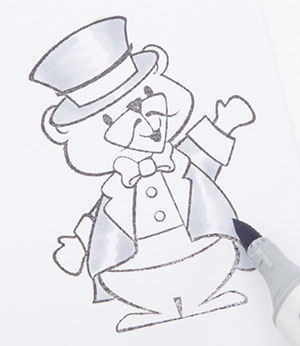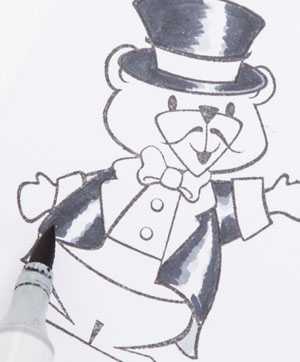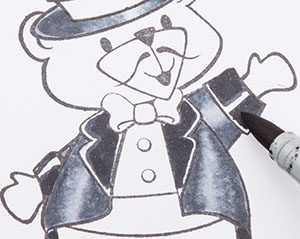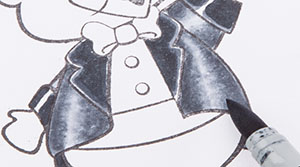
How to Color Using Black
By Colleen Schaan
All color the human eye sees is based entirely on light -- even the color black.
Science states the color black absorbs all light; however, art disagrees. Reflected light is a key factor when coloring something which appears black.
You may have wondered how to color something in a stamped or drawn image black. You may even have gone as far as picking up a black marker and filling in the image. If you have, you quickly realized that coloring black isn't just about black. To realistically create the look of depth and dimension in a black object, you need to consider the highlights, the mid-tone, and the shadows. In essence, all the shades of gray.
Materials
- White cardstock (X-Press It Blending Card)
- Stamp image (The Cat's Pajamas)
- Dye ink pad (IMAGINE Crafts/Tsukineko Memento tuxedo black)
- Copic® markers: C3, C5, C7, C9
- Copic® Colorless Blender
- Black Multiliner
- Copic® Opaque White paint
Step 1: Stamp the image in black ink for best consistency (Photo 2).

Step 2: Start with the soft blend of a cotton material. For this process, start by adding flicks of the lightest gray (C3) to the areas of shadow and mid-tone. Leave the areas of highlight white for now (Photo 3).

Step 3: Darken the mid-tone and shadow area with flicks of a darker gray (C5). Leave a small amount of the light gray visible (Photo 4).

Step 4: Darken the shadows and a small portion of the midtone with the darkest gray (C7). Notice that the area between layers and the highlight area is choppy and uneven (Photo 5).

Step 5: Begin the blending process by adding C5 to the seam between the dark and medium tones (Photo 6).

Step 6: Continue blending with C3. Fill in the highlight area with the lightest ink as you blend the shades together (Photo 7).

Step 7: Because I want this to appear as a soft, black cotton fabric, I want the blend to be very soft (almost over blended) and the shades to be slightly lighter. To do this, apply flicks of the Colorless Blender from the highlight area out toward the shadow areas (Photo 8).

Step 8: For fabric that is shiny (like satin), I will take a slightly different coloring approach for black. Begin by drawing in the mid-tone and shadow with the darkest gray (C9). Notice that the edges between the shading and the highlight are very crisp. Also note that I leave a slight highlight along the edge of any area where a black object overlaps another black object (Photo 9).

Step 9: Slightly soften the stark edges with a mid-tone gray (C5). Do not blend and do not cover the highlight areas (Photo 10).

Step 10: Create dimension between black objects by adding cast shadows with a black Multiliner (Photo 11).

Step 11: Add any missing or lost highlights to high-contrast areas with Opaque White paint (Photo 12)

Tips & Tricks
- Pick a gray blending family that will fit with the tone/feel of your image.
- Use soft blends to create the look of soft, absorbent surfaces.
- Use crisp edges and high contrast to create the look of shiny, reflective surfaces.
This Copic tutorial was first published in the Autumn 2015 issue of CardMaker magazine. To get more information on Copic marker techniques:
- Purchase a copy of Colleen's book Copic Coloring Guide.
- Check out Colleen's blog, www.distinctivetouches.com.
- Subscribe to CardMaker magazine, where Colleen has a regular column featuring Copic marker techniques.


